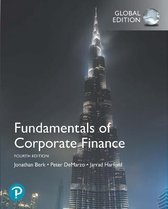Summary
Summary Fundamentals of Corporate Finance plus Pearson MyLab Finance with Pearson eText, Global Edition, ISBN: 9781292215198 Accounting (PPM122)
- Course
- Institution
- Book
best study guides, study notes and summaries about corporate finance corporate governance risk management investment analysis capm wacc Corporate finance corporate governance risk management investment analysis capm wacc Study guides, Class notes & Summaries
[Show more]





